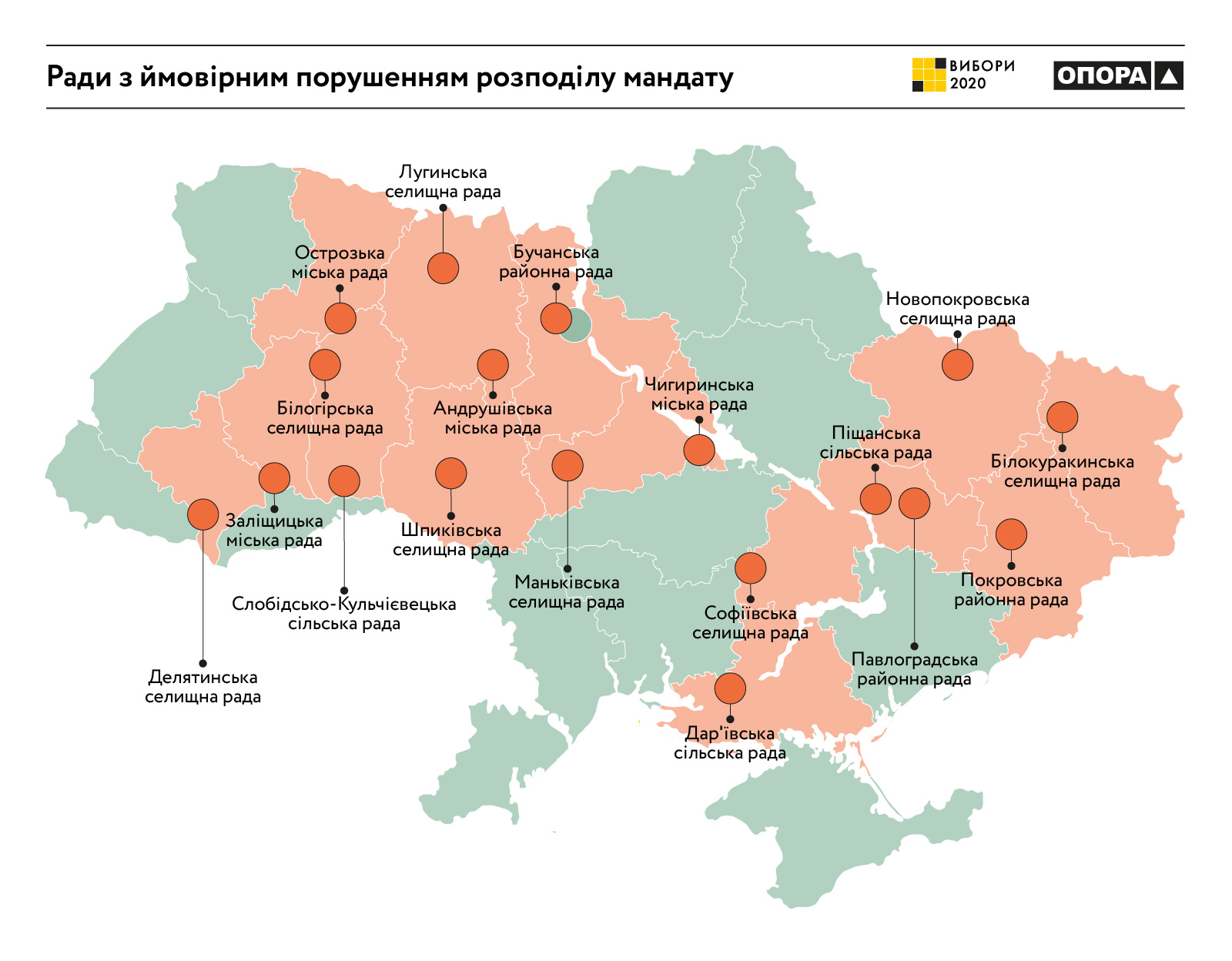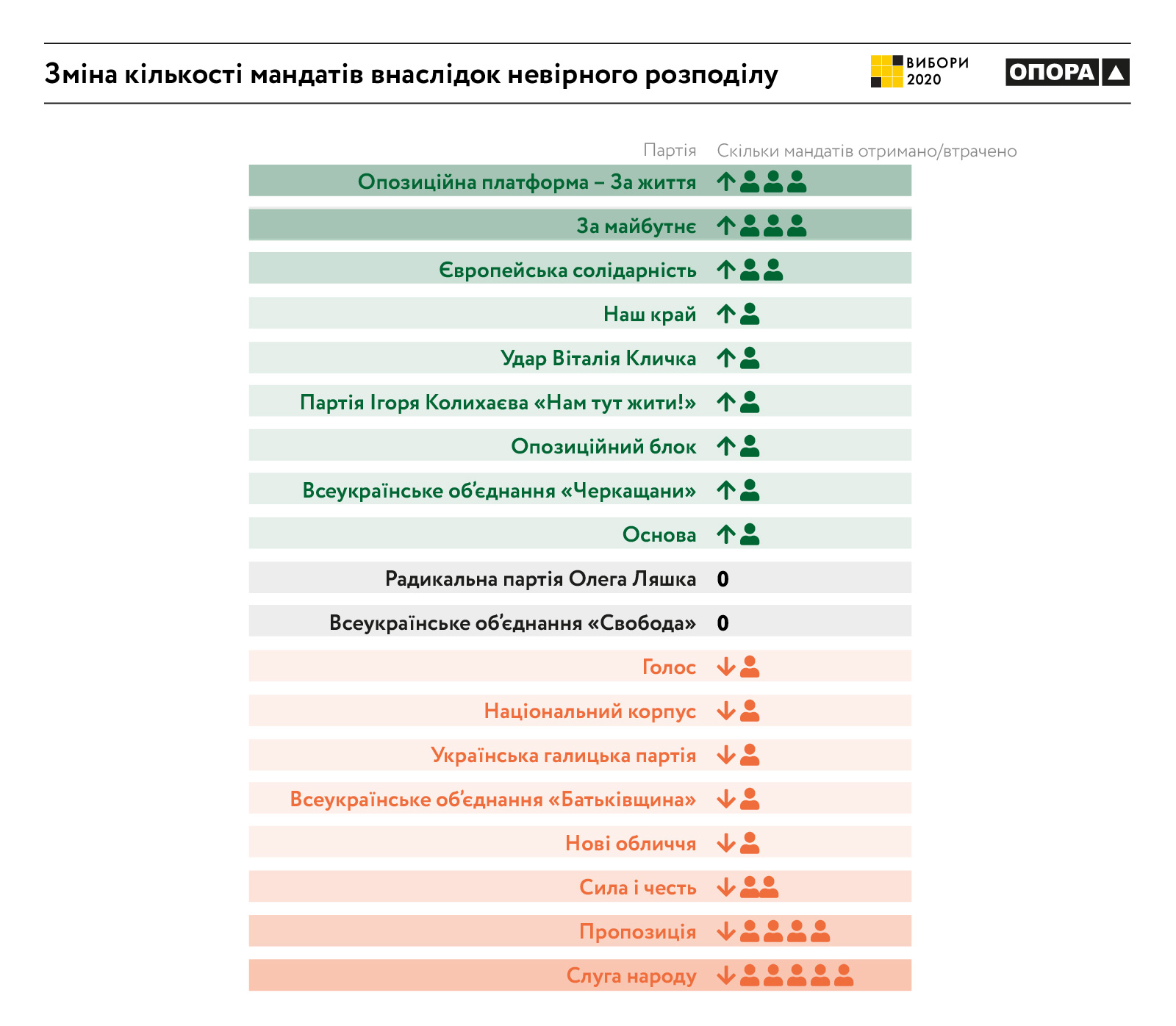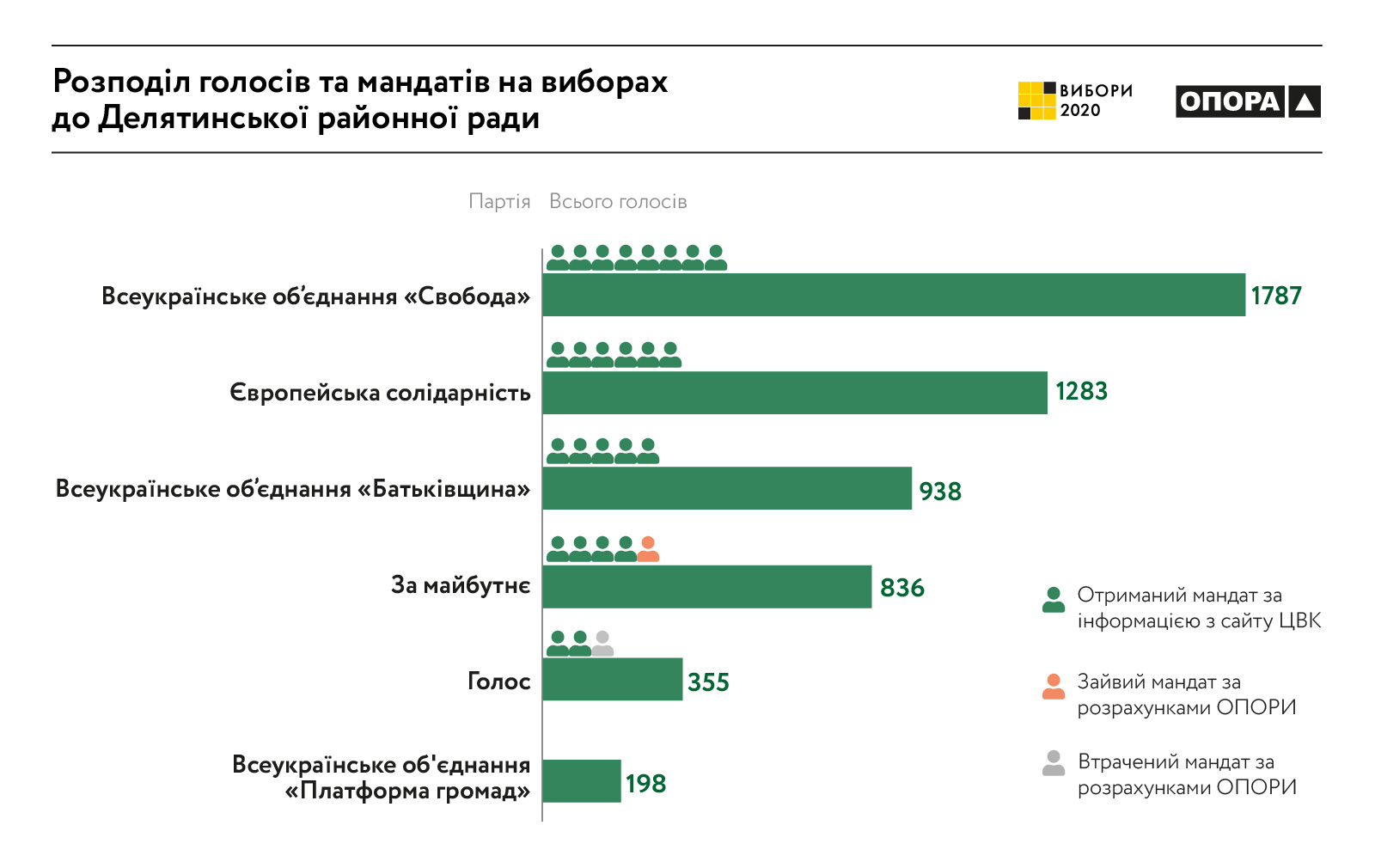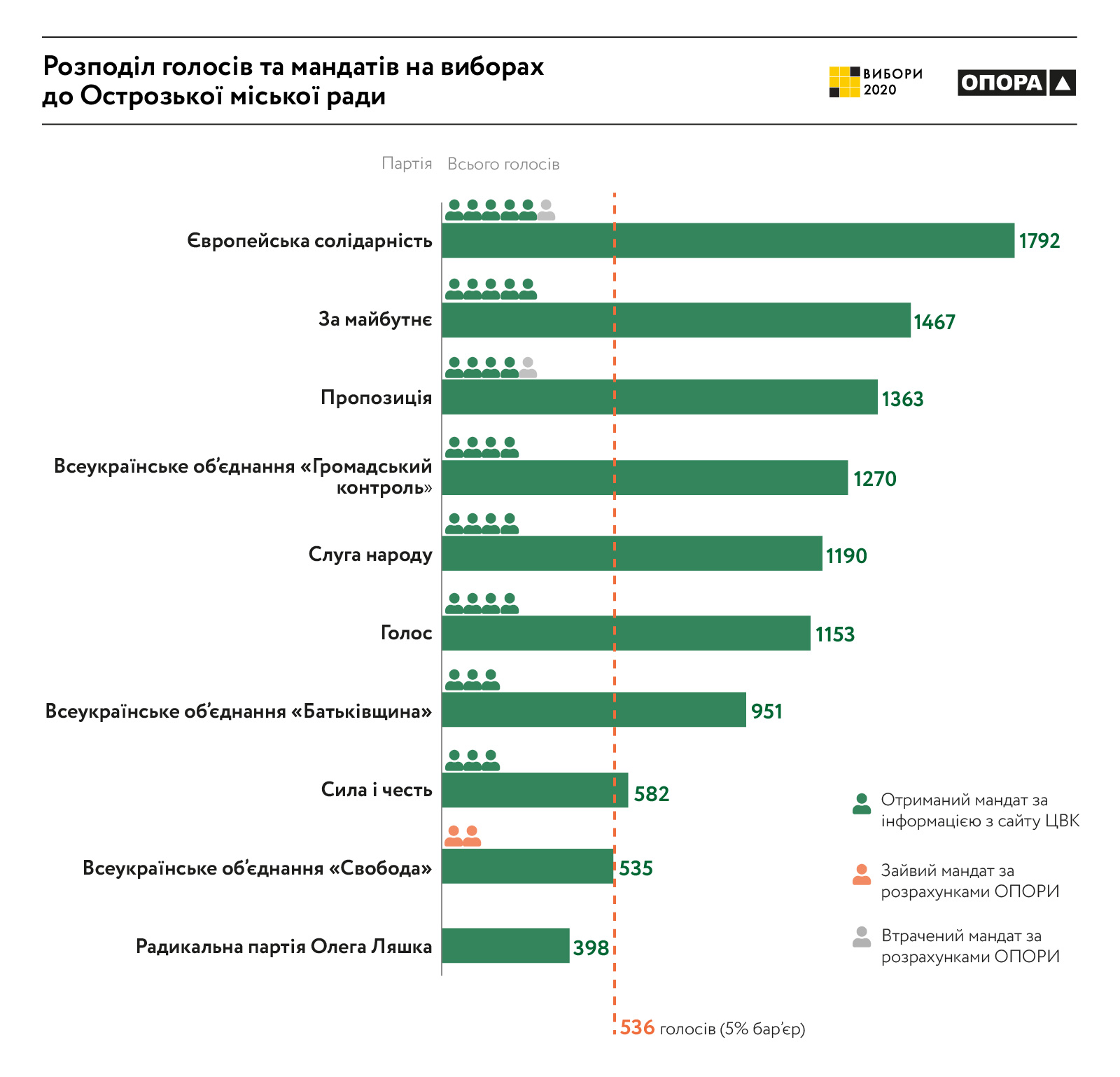After the 2015 regular local elections in Ukraine, OPORA conducted its investigation. The investigation revealed numerous cases when the incorrect distribution of seats or specific manipulations with the protocols influenced the number of distributed mandates in councils. Thus, OPORA had to visit archives throughout Ukraine to get copies of the original protocols. Having digitized and verified them, we noticed many breaches in the distribution of mandates. Here are some examples of such manipulations with the determination of election results:
- Kyiv Oblast Council;
- Kamianets-Podilskyi City Council;
- Vasylkiv Raion Council;
- Makariv Raion Council;
- Monastyryshche City Council;
- Uhniv City Council.
It seems that history repeats itself in the 2020 regular local elections. OPORA analyzed all election results for oblast and raion councils, which were available on the Central Election Commission website, as well as for communities where elections were held under a proportional system. The verification covered only the number of mandates received by parties, not considering the seats in the territorial districts and party lists. OPORA calculated the distribution of seats between parties based on the Election Code and compared it with the corresponding data on the CEC's website.
According to the calculation results, OPORA detected 18 cases in 14 regions of Ukraine, indicating probable violations in the mandate distribution*. Most of them are in Dnipropetrovsk oblast, in three councils of different levels at once. The infographic below shows all councils where, according to the information published on the CEC's website, was an incorrect distribution of seats.

* If copies of tabulation protocols in council elections are not present, OPORA may only allege a possible violation of the procedure for the distribution of seats. Besides that, the information published on the CEC's website, delivered by State Voter Register maintenance bodies, may contain inaccuracies and is not official information on the voting results. If you have copies of tabulation protocols from any of the councils mentioned above, please send them us at [email protected].
Having aggregated all the OPORA's data, we may see that the Servant of the People party has lost the biggest number of seats (5) due to incorrect distribution, as well as the Propozytsia party (4). Instead, the Opposition Platform - For Life (+3 seats) and the For the Future political party (+3 seats) increased their local government representation.

We will consider some cases of incorrect mandate distribution below.
Nine political parties took part in the election to Pavlohrad district council, six of which overcame the electoral threshold. However, according to our calculations, the seats in the district council were distributed incorrectly. As a result, the European Solidarity party received one extra mandate, while the Propozition party has lost one.

The information on the number of votes received by the parties is supported by scanned copies of district tabulation protocols, published on the Central Election Commission's website.
To prove the incorrect distribution, we provide detailed calculations of the number of seats received in the table.
Besides Pavlohrad District Council, OPORA has detected a violation of the counting procedure in Pokrovsk District Council, Donetsk oblast. OPORA has also found proof of such violation in the court register. Thus, the For the Future political party challenged the Pokrovsk District Election Commission's tabulation protocol in the Donetsk District Administrative Court. According to the protocol, the For the Future party did not receive one mandate, which went to the Opposition Bloc political party. The Donetsk District Administrative Court declared this Pokrovsky District Election Commission's tabulation protocol illegal and invalidated it. The Court also obliged the Commission to distribute mandates in line with the election legislation.
In the case with the Pavlohrad District Council, the For the Future party did not challenge the election results to Deliatyn Village Council of Nadvirna Raion (Ivano-Frankivsk oblast), where a similar violation probably took place in the distribution of council seats. According to the election results, published on the CEC's website, as well as scanned copies of the district tabulation protocols, five of six political parties that took part in the election overcame the 5% threshold. But this time, the For the Future party received one extra seat, which belongs to the Holos party.

The table contains detailed calculations on the distribution of seats in the Deliatyn Village Council.
UPD. According to the tabulation protocol in the Ostroh City Council, published on the Ostroh City Council's website, the distribution of seats took place in accordance with the election legislation. Thus, the CEC's website contains an erroneous protocol for TED #3, according to which the Propozition party received 100 votes more. The extra 100 votes are also present in the election results on the CEC's website. Because of this error, our analysis showed an error in the distribution of seats. This is one more proof that citizens must have access to official election results.

OPORA also detected one more case in the election to Ostroh City Council. Thus, according to information published on the CEC's website, 10 political parties participated in the elections, running for 34 seats. Thus, 9 parties overcame the 5 percent threshold, and took part in the distribution of seats later. According to OPORA's calculations, the Svoboda party did not get the required number of votes and should not have participated in the distribution of seats. Thus, AUU Svoboda received 535 votes, which is 4.9999% of all votes, while the Election Code clearly states that a political party must receive 5% or more votes to participate in the distribution of seats. In the case of Ostroh City Council - 536 votes. Thus, parties the European Solidarity and the Propozition lost one mandate each, which went to the AUU Svoboda party.
The analysis of district tabulation protocols in the election to Ostroh City Council confirmed OPORA's calculations. The table contains a detailed calculation of seats received.
Electoral legislation does not clearly regulate the consequences, which may occur when errors in the distribution of seats are detected after the first session and the acquisition of powers by councilors. Appeals against the order and sequence of distribution of seats are possible only in court. If the councilors have already acquired powers, they can be terminated only based on a court decision.
Providing that the information published on the CEC website is confirmed, law enforcement agencies should initiate criminal proceedings on the facts and, in the course of the pre-trial investigation, establish whether the false information was intentionally entered into the election protocols during the distribution of seats. In case actions of territorial election commission members were intentional, such persons shall be prosecuted under Article 157-3(2) of the Criminal Code of Ukraine.
This information also indicates the need to professionalize members of election commissions, at least at the level of district and territorial election commission officials, and to automate the processes related to the distribution of seats in order to avoid such mistakes in the future. Besides that, it also proves there is a problem with publication of local election outcomes by the Central Election Commission. The lack of tabulation protocols for the relevant councils does not allow to verify the information published on the website.
The following is a complete list of councils where violations have probably occurred during the distribution of seats:
Vinnytsia oblast:
Dnipropetrovsk oblast:
- Pavlohrad Raion Council;
- Kryvyi Rih raion, Sofiivka Settlement Council;
- Novomoskovsk raion, Pishchane Village Council;
Donetsk oblast:
Zhytomyr oblast:
Ivano-Frankivsk oblast:
Kyiv oblast:
OPORA also detected one more case in the election to Ostroh City Council. Thus, according to information published on the CEC's website, 10 political parties participated in the elections, running for 34 seats. Thus, 9 parties overcame the 5 percent threshold, and took part in the distribution of seats later. According to OPORA's calculations, the Svoboda party did not get the required number of votes and should not have participated in the distribution of seats. Thus, AUU Svoboda received 535 votes, which is 4.9999% of all votes, while the Election Code clearly states that a political party must receive 5% or more votes to participate in the distribution of seats. In the case of Ostroh City Council - 536 votes. Thus, parties the European Solidarity and the Propozition lost one mandate each, which went to the AUU Svoboda party.
The analysis of district tabulation protocols in the election to Ostroh City Council confirmed OPORA's calculations. The table contains a detailed calculation of seats received.
Electoral legislation does not clearly regulate the consequences, which may occur when errors in the distribution of seats are detected after the first session and the acquisition of powers by councilors. Appeals against the order and sequence of distribution of seats are possible only in court. If the councilors have already acquired powers, they can be terminated only based on a court decision.
Providing that the information published on the CEC website is confirmed, law enforcement agencies should initiate criminal proceedings on the facts and, in the course of the pre-trial investigation, establish whether the false information was intentionally entered into the election protocols during the distribution of seats. In case actions of territorial election commission members were intentional, such persons shall be prosecuted under Article 157-3(2) of the Criminal Code of Ukraine.
This information also indicates the need to raise the competence of election commission members, at least at the level of district and territorial election commission officials, and to automate the processes related to the distribution of seats in order to avoid such mistakes in the future. Besides that, it also proves there is a problem with the publication of local election outcomes by the Central Election Commission. The lack of tabulation protocols for the relevant councils does not allow to verify the information published on the website.
The following is a complete list of councils where violations have probably occurred during the distribution of seats:
Vinnytsia oblast:
Dnipropetrovsk oblast:
- Pavlohrad Raion Council;
- Kryvyi Rih raion, Sofiivka Settlement Council;
- Novomoskovsk raion, Pishchane Village Council;
Donetsk oblast:
Zhytomyr oblast:
Ivano-Frankivsk oblast:
Kyiv oblast:
Luhansk oblast:
Rivne oblast:
Ternopil oblast:
Kharkiv oblast:
Kherson oblast:
Khmelnytskyi oblast:
- Shepetivka raion, Belohiria Settlement Council;
- Kamianets-Podilskyi raion, Slobidka-Kulchiievetska Village Council;
Cherkasy oblast:
Luhansk oblast:
Rivne oblast:
Ternopil oblast:
Kharkiv oblast:
Kherson oblast:
Khmelnytskyi oblast:
- Shepetivka raion, Belohiria Settlement Council;
- Kamianets-Podilskyi raion, Slobidka-Kulchiievetska Village Council;
Cherkasy oblast:
